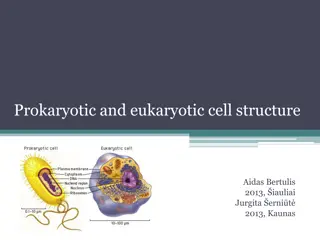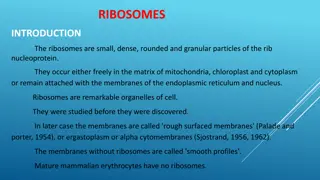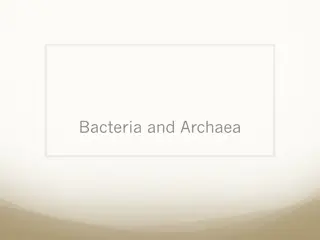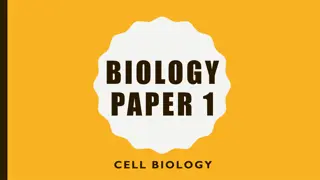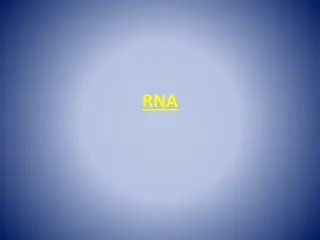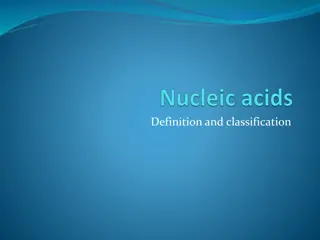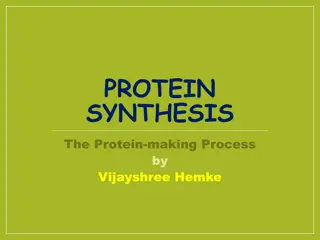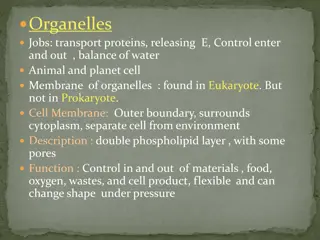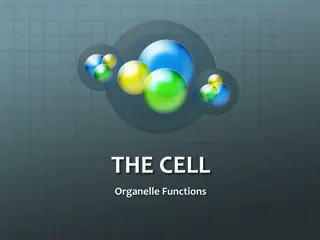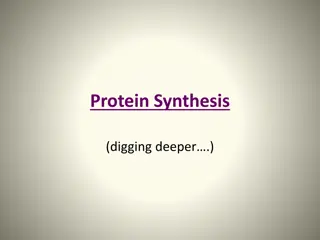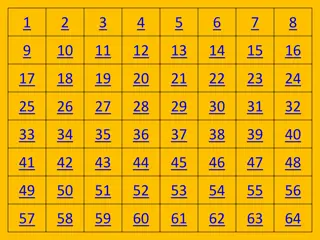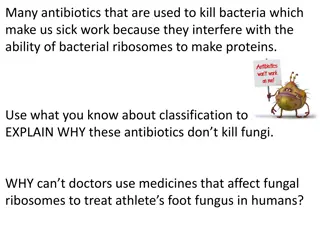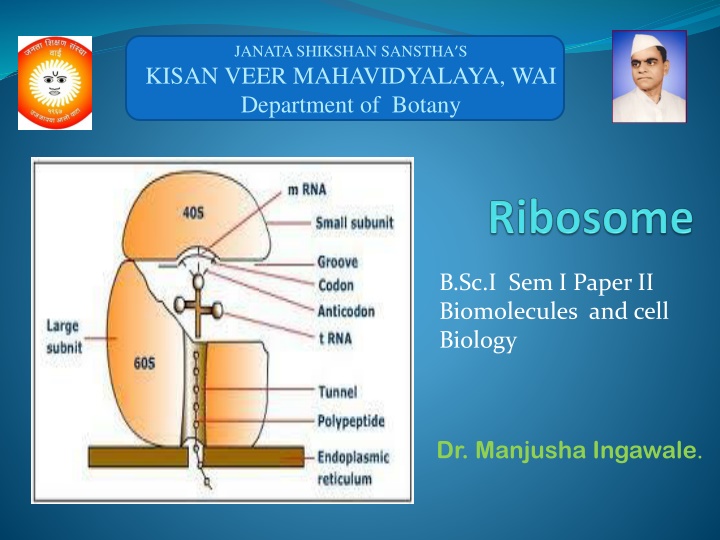
Ribosomes and Their Role in Protein Synthesis
Explore the significance of ribosomes in cellular processes, their occurrence in prokaryotic and eukaryotic cells, and the classification based on size and sedimentation coefficient. Learn about the different types of ribosomes and their roles in synthesizing proteins within living cells.
Download Presentation

Please find below an Image/Link to download the presentation.
The content on the website is provided AS IS for your information and personal use only. It may not be sold, licensed, or shared on other websites without obtaining consent from the author. If you encounter any issues during the download, it is possible that the publisher has removed the file from their server.
You are allowed to download the files provided on this website for personal or commercial use, subject to the condition that they are used lawfully. All files are the property of their respective owners.
The content on the website is provided AS IS for your information and personal use only. It may not be sold, licensed, or shared on other websites without obtaining consent from the author.
E N D
Presentation Transcript
JANATA SHIKSHAN SANSTHAS KISAN VEER MAHAVIDYALAYA, WAI Department of Botany B.Sc.I Sem I Paper II Biomolecules and cell Biology Dr. Manjusha Ingawale.
Introduction -: Ribosomes are cytoplasmic granules composed of RNA and protein, at which protein synthesis takes place. They were first observed by Robinson and Brown(1953) in plant cell. Palade in 1955 observed in animal cells. He isolated the ribosome & detected RNA in them that s why ribosome are called as Ribonucleoprotein particle. Typical prokaryotic ribosomes is of 70S. Eukaryotic ribosomes is of 80S.
Occurance & Distribution In prokaryotic cell it is found in the free state that is in form of polyribosomes (2 or more ribosomes are held together by mRNA). These polyribosomes is present region surrounding the DNA. In eukaryotic cell ribosomes either occurs freely in the cytoplasm or remain attached to the membrane of endoplasmic reticulum and into the matrix of mitochondria & chloroplast.
Number - : They are mostly found in all living cells which can synthesize protein. The number and conc. of ribosomes are directly related to the RNA content of the cells. The no. of ribosomes is high in the cells which are active in protein synthesis & low in cells where protein synthesis is low. In E. coli there are about 20,000 to 30,000 ribosomes present per cell. They are the site of protein synthesis. In ribosome various amino acids are joined in specific sequence so as to form polypeptide chain, from which protein are formed. polypeptide chain, from which protein are formed. They are mostly found in all living cells which can synthesize protein. The number and conc. of ribosomes are directly related to the RNA content of the cells. The no. of ribosomes is high in the cells which are active in protein synthesis & low in cells where protein synthesis is low. In E. coli there are about 20,000 to 30,000 ribosomes present per cell. They are the site of protein synthesis. In ribosome various amino acids are joined in specific sequence so as to form
Types of Ribosomes - : Based on size, sedimentation coefficient and occurrence ribosomes can be classified into three types 55s ribosomes - It is present in cell organelles such as mitochondria and chloroplast, formerly they were thought to be 70s but they have sedimentation coefficient of 55s it is smallest & consist of 2 subunit i.e. larger 40s &small 30s 70s ribosomes - these are smaller in size & are found in prokaryotic cell. eg. Bacteria, BGA it consist of 2 subunits i.e. large 50s & 30s subunit. The 50s subunit is composed of 23sRNA, 5s RNA & 30 protein. The 30 s subunit has 16 s RNA & 20 different protein Molecular wt-2.7x106 Dalton 80s ribosomes It is found in eukaryotic cell. eg. Algae, fungi, higher plants & animals. It is made up of 60s & 40s subunit Molecular wt 4x106Dalton
Chemical composition The ribosome contain RNA, protein, enzymes, lipids & metallic ion Ribosomal RNA The RNA present in the ribosome are called Ribosomal RNA or rRNA. In eukaryotic cells RNA are found in three forms namely 28s RNA, 18s RNA & 5s RNA. In prokaryotic ribosome they are in form of 23s RNA, 16s RNA & 5s RNA Ribosomal enzymes - :Ribosome contain a variety of enzymes required for protein synthesis. Metallic ion The metallic ion present in ribosome are Mg, Ca, Mn, Fe, etc. Regeneration or Biosynthesis of Ribosome- The biogenesis of ribosome in bacteria (prokaryotic) takes place inside the cytoplasm because of the absence of nucleolus. In eukaryotic cells the process of biogenesis of ribosome is completed & occurs inside the nucleolus.
Ultra structure of Ribosomes Ribosomes are mostly spherical or elliptical str. of diameter 250A0 Each ribosome having porus & hydrated structure composed of 2 subunit. One subunit is smaller in size & other is larger in size. Small subunit is situated above the larger subunit like a cap. Both subunits remain separated by a narrow cleft. The small subunit is responsible for the formation of the initiation complex. The large subunit catalyzes the peptide bond formation and provides the path for the nascent polypeptide chain
Prokaryotic and Eukaryotic Ribosome - The 70s ribosome is composed of 2 subunit smaller 30s & larger 50s subunit. Its larger subunit is pentagonal in shape & having diameter 160 to 180 A0 While 80s ribosomes is having 220 to 300A0 It is composed of smaller 40s & larger 60 subunit. Larger 60 subunit remain attached to the membrane of ER & to the nuclear membrane, the 40s subunit is smaller in size & forming a cap like structure. Both these subunit separated by narrow cleft (space) while only center of 2 subunit of 80s ribosome rounded space of about 40 60 Ao diameter is present 3os 4os 60s 50s Prokaryotic ribosome (70s) Eukaryotic ribosome (80s)
The larger subunit of each ribosome contains 2 slots called P site or donor site & A site or acceptor site. During protein synthesis tRNA carrying peptide chain is attached to the P site. The tRNA carrying activated amino acid is attached to the A site Large subunit A Site P Site mRNA A U G C U A C U U C G Small subunit
The smaller subunit shows three regions namely head, base, platform. Platform region separate head region from base region by forming a cleft in between them. The larger subunit shows 3 parts i.e. a ridge, a central protuberance and a stalk. The ridge & central protuberance separated from each other due to valley region. These 2 subunit fitted together & from a complete unit of ribosome. These ribosome denoted by their coefficient (s)[ s- Svedberg unit for sedimentation coefficient, related to molecular wt of ribosome. measured or sedimentation
Dissociation and Association of Ribosome - The ribosomal subunit remain freely in the cytoplasm. In beginning of the process of protein synthesis the 2 subunit unite together & at the end of protein syn. they dissociate. similarly 2 ribosome subunit together to form dimer. Many ribosomes are held together by mRNA & from polyribosome. The association & dissociation of ribosome subunit depend on mg++ ion conc. in the cytoplasm. If the conc. of mg ion is less than 0.001 molar then 2 ribosome unit separated from each other (dissociation ) while. If conc. of mg ion is higher than 0.001 molar than 2 ribosomal subunit fuse together (association)
Functional significance Protein synthesis The ribosome plays important role in protein synthesis. The ribosome subunit remain freely in the cytoplasm. In the beginning of the protein synthesis these two subunit unite together and at the end of protein synthesis it again dissociate Process starts from DNA through transcription Translation is where ribosome comes in. Translation occurs when protein formed from code on mRNA Ribosome carries out the translation of the nucleotide triplets
Initiation: The first phase of translation Translation begins when mRNA attaches to the 30S tRNA comes and binds to mRNA where nucleotide code matches This triggers 50S binding to 30S. 50S is where all tRNAs will bind.
Elongation The large subunit of ribosome catalyzes the formation of peptide bond methionine & amino acid (proline) which is carried by aminoacyl tRNA with help of peptidyl transferase enzyme. between
Elongation (continued) First tRNA now detached from its amino acid, and it leaves ribosome & aminoacyl tRNA acts as peptidyl tRNA and it transfer to P site & empty A site for new amino acid. Then this ribosome move in forward direction & repeat this process to read new triplet codon on mRNA
Termination End of translation - After complete synthesis of polypeptide chain that is when ribosome reaches the region at termination termination of occurs. The subunit dissociates from each other & polypeptide chain releases in cytoplasm. All the phase in protein synthesis namely elongation & termination are completed in ribosome and the str. of ribosome provide all essential factor for the process. codon protein then syn. of ribosome initiation,
Protection -: The mRNA passing through the ribosome is protected from nuclease - After binding these two subunit, a gap or groove exists between two subunit & in this gap mRNA mole is located. As mRNA molecule remain in gap, the ribosome protect a stretch of 25 nucleotide of mRNA from degradation by ribonuclease Similarly newly synthesized polypeptide chains are protected from proteases - Structure of ribosome is very suitable for the elongation of a developing peptide chain. The larger subunit of ribosome shows presence of tunnel or channel and developing peptide chain grows this tunnel due to which ribosome protect a peptide segment of about 30-40 from degradation of proteolytic enzyme.

